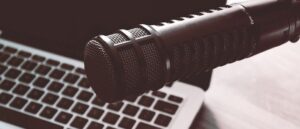Equipment:
While you could opt for high-end recording programs such as Pro Tools, there are several reputable free options out there. The first, Audacity, is an open-source editing and recording program that’s compatible with most operating systems and works well for beginners. Though it dons a rather unflattering exterior, you’ll be able to record live audio directly into the application, or import a variety of different audio files, including MP3 and WAV. The software even touts recovery options in the event that your system crashes. Acoustica Basic Edition is another free option, one that provides audio recording and editing within a well-designed interface. However, you’ll have to pay extra for multi-track editing and other advanced features. We use NCH Wavepad.
Microphone(s)
In all reality, podcasters should consider purchasing an external microphone. USB mics plug directly into your computer and interface with your recording software, thus offering superior sound and greater flexibility than your computer’s built-in microphone. Also, be sure to buy the right number of mics for your show, as you’ll want all cast members to be heard loud and clear. And if you’re going to be using a mixer, be sure to buy microphones that can plug into it! Not all mixers support USB mics, and not all mics will work with standard mic plugs.
Headphones
These don’t have to be all that fancy; all you need is a decent pair of headphones so you can hear yourself and any guests you might have on the show. If you’re using a mixer, however, these become a requirement, as you will need to have headphones in order to correctly adjust the audio channels or hear your guest if they are from another location. After all, you can only do so much in post-production editing.
Post-production
Not only applicable to podcasters mixing interfaces to create multitrack recordings, post-production editing is key to nearly every podcast. Masterful editing takes time to learn, though, so don’t be concerned if you can’t pull off some of the more advanced procedures in the beginning. As far as basics go, you’ll want to ensure your vocal levels are roughly the same for each speaker and work on tightening dead space between phrases. If you have other audio components, such as miscellaneous sound effects and background music, make sure those levels are low enough that you can still hear the speakers. You can also work to trim your file to a specified length, or adjust the bit rate and other audio facets for your desired medium. Editing deserves a tutorial on its own, but for most casual podcasters, most of it can be done without expensive software or substantial time. We use NCH Mixpad
Uploading to a host site
Sadly, there’s really no point in a podcast if you don’t intend to share it with others. To do so, you must host your resulting audio file somewhere online, prior to linking to the file from elsewhere. There are numerous ways to go about hosting your podcast, though some are better than others. Websites like WordPress and Blogger provide a free and simple means for hosting audio files, but they’re limited in terms of flexibility and exhibit a general lack of control. HostGator, though more complicated, offers more advanced features and a domain at a relatively low price point. However, if you do go with WordPress, the site will automatically add the RSS2 enclosure when you add a link to your audio file, which makes it possible to use as a podcast. Uploading your audio file will make the necessary RSS2 enclosure tag and can generate your XML feed.
Top podcast hosts: (http://schoolofpodcasting.com/is-soundcloud-a-legitimate-option-for-podcasting-8-podcast-media-hosting-companies-compared/)
- Soundcloud – one of the best players
- Blubrry.com – ease of publishing
- Libsyn.com – the gorilla serving the largest podcasters
- PodBean – allows you to manage your mailing list
- Amazon S3 – no stats
- Podmatic – Limited bandwidth, limited storage, and no way to leave (you hijack my feed)
- Buzzsprout.com – You change my file, and I have to ask to leave.
- Spreaker.com – You mess with my ID3 tags, and there is no way to leave.Add ID3 Tags
- ID3 Tags are the information that is stored inside the media file. For example when you play an mp3 on your iPod and a picture shows up on the screen that image is an ID3 tag. If you don’t do this, your podcast looks very amateur. You can use use mp3tag software (free) for this. If you are on a Mac check out ID3 Editor. We use Stamp ID3 Tag Editor.
Listen to the full podcast on iTunes
